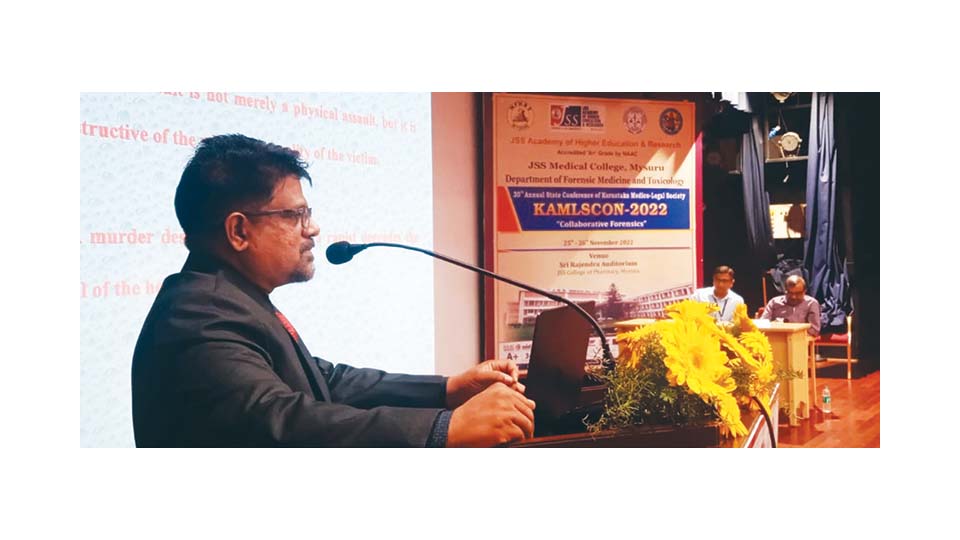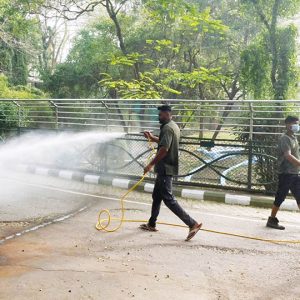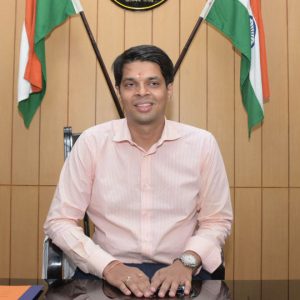Joint Director of Forensic Science Laboratory speaks on scientific reporting of sexual offences
Mysuru: Proper management of biological evidence collected in a crime scene where a girl or a woman is raped is critical as it affects the integrity of the final results. If the biological evidence is not examined, collected, documented and analysed, it will lead to the rapist escaping conviction, said Dr. M.V. Pradeep Kumar Joint Director (technical, research and development) State Forensic Science Laboratory, Bengaluru.
He was delivering a lecture on the ‘scope of collaboration of State Forensic Science Laboratory, for authentic scientific reporting of sexual offences including cases under Protection of Children from Sexual Offences Act’ at the two-day 30th Annual State Conference of Karnataka Medico-Legal Society (KAMLSCON 2022).
The conference, with the theme ‘Collaborative Forensics’, concluded last evening at Sri Rajendra Auditorium, JSS College of Pharmacy. The event was organised by the Department of Forensic Medicine and Toxicology, JSS Medical College.
Evidence gathering critical
Special attention has to be paid to examining the victim and also the other steps involved in the selection, collection, packing, sealing, labelling, storage, preservation, transportation and maintenance of biological samples, Dr. Pradeep Kumar noted.
“Most of the time, there is no coordination between the Police, the forensic team and doctors. The evidence collected from the personality of the victim has to be matched and corroborated with the accused — like blood and semen samples, bite marks, and swabs collected from the private parts — and in many cases, both the victim and the accused are sent for medical tests separately due to the lack of understanding and coordination,” he explained.
There is also a lack of coordination between the hospital where the medical examination is carried out and the forensic laboratory where the evidence is sent. As a result, hospitals often do not get a copy of the chemical analysis report, although the doctor who conducted the medical examination is supposed to give an opinion based on the report, he said.
Securing the crime scene
Securing the crime scene is critical and the evidence should be collected in such a way that the gap between the victim and the accused is cemented. “The rationale of collecting forensic evidence is to link a suspect to the victim of the crime. In order to collect suitable forensic evidence, the medical practitioner must understand the types of evidence present in sexual assault cases. Specimens may corroborate contact between individuals or between an individual and a location and evidence of contact occurs at the time of the offence,” he noted.
Explaining the technical details, Dr. Pradeep Kumar said that the registered medical practitioner shall, without delay provide the report to the investigation officer who shall forward it to the Magistrate. “Even a single hair with root, if left by the accused on the crime scene or on the clothes or body of the victim or even the footprint at the crime scene can link the accused with the crime through DNA profiling,” he said.
Sympathy and sensitivity vital
On the role of investigating officer in sexual assault cases, he said that the investigator should first secure the scene of the crime. “The victim must be treated with utmost sympathy and sensitivity and must be given immediate medical help,” he added.
“Sexual assault is not merely a physical assault, but it is destructive of the whole personality of the victim. A murder destroys the body but a rapist degrades the very soul of the helpless female,” Dr. Pradeep Kumar said.
DNA sampling
DNA is one of the important tools to identify whether the accused has or has not committed a particular crime. This significance and reliability of DNA are because of its unique character. In cases of rape, the DNA can be traced from the saliva, semen and blood of the accused found on the clothes, body of the victim and also from the articles in the place of crime, Dr. Pradeep Kumar said.
The investigating authority has to take utmost care that these extracts are traced and sent to the examination laboratories within the prescribed time provided for each extract so as to achieve proper results, he explained.








Recent Comments